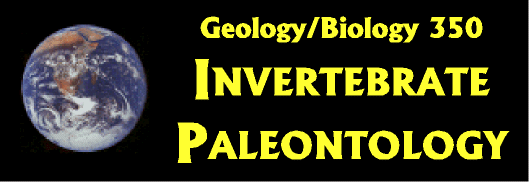 The Origin and History of Life on Earth
The Origin and History of Life on Earth
|
Lynn S. Fichter - Fichtels@jmu.edu James Madison University; 233 Miller Hall - phone 6531 |
 The Origin and History of Life on Earth
The Origin and History of Life on Earth
|
|
Syllabus Course Schedule Text Books Part One Part Two Part Three Final Exam |
Catalog Description The history of non-vertebrate life from its origin, through evolving biogeochemical cycles, origin of eukaryotes and multicellularity; evolutionary records of all major groups and theoretical issues such as major group origins, adaptive radiation patterns, extinctions, functional adaptations, and paleoecology. 4 credits (3, 2)
|
|
Office Hours Monday and Wednesday 10-11; T/T 8-10; By appointment; or anytime I am in my office, which is most of the time, and not immediately tied up with something else. Just come by, or call to see if I am available. Final Exam Time |
What the Course is About
Read the average biology textbook and you might think that we understand the nature of life and how it evolved. Nothing could be farther from the truth. Every theory concerning the origin and history of life is rife with controversy. Deep differences of opinion exist over the tempo of evolutionary change (gradual vs. punctuational), the motor of organic change (internal vs. environmental), and the direction of evolution (directional and progressive vs. steady state - life as a random walk). What is more these different readings of the record of life have existed ever since Darwin's time. Trying to understand life solely from the study of living organisms is like trying to understand a 2 hour movie by just watching the last 5 minutes. You may learn the final outcome, but not how or why, and you would miss all the interesting things that have happened along the way. For the truth is, much of the mystery of life is still a mystery, buried in the 3.6-3.8 billion year history of life. There are, however, things we do know about the history of life and the earth.
The paleontological study of life is not simply about the past it is also about change and continuity. Most of all it is about the long run. Earth environments and life's relationship to those environments cannot be understood in isolation. Environmental conditions that exist today are embedded in and reflect processes that can only be understood at time spans extending far beyond the short window of human experience, far beyond experiments run under controlled laboratory conditions and for time spans that are geologically instantaneous. The study of paleontology tells us that life processes in a geological context are historical events; their magnitude, structure, cause, and consequences have been highly variable. Furthermore, these variations are patterned in ways we are only beginning to understand, and that cannot be understood only from study of the present. Life can be understood only in terms of the earth system as a whole traced through it 4 billion years of dynamic change. Finally, unraveling the history of life requires many lines of evidence, biological, geological, paleontological, biochemical, and biogeochemical. This course applies all these lines of evidence to understand not only life itself, but also the scientific controversies that surround our study of it. |
| Test Questions |
Supporting Pages
|
|
The essay questions you have ahead of time to prepare for and are linked individually below. I will add them one by one as we cover the material. Essay Questions - pdf files
|
New Illustrations Not In Notebook
Selected Lecture Notes - pdf files Other Links From/For Lecture |
|
Test Questions
Preparing For the Exams
The second exam follows the same rules and procedures as the first exam. Refer to Exam Number One OR Test Instructions for a discussion of those rules and procedures. One reminder. Some of the questions below are minimally stated. You are expected to fill out the details and tender a well rounded, complete exploration of the subject at hand, as we did in class, supplemented by any readings associated with the subject. |
New Illustrations
Selected Lecture Notes - pdf files
Other Links From/For Lecture
|
|
Test Questions
|
Selected Lecture Notes - pdf files
Other Links From/For Lecture
|
|
Lab Stuff
|
|
|
This table captures anything that applies to the laboratory. It is a random assortment of odds and ends. |
|